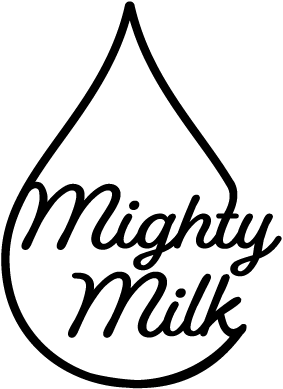If you want to breastfeed your baby, I want to tell you three important things you should know before you give birth. Many new mothers struggle with breastfeeding. In fact, while the vast majority of moms in the US start off breastfeeding their babies at birth, only a small percentage continue for as long as they’d hoped to. But here’s the good news: a few simple tips can go a long way in helping you reach your breastfeeding goals and avoiding some of the common challenges that can lead to families introducing formula or stopping breastfeeding all together sooner than they’d wanted to.
Tip 1: Your baby will need to nurse very frequently.
Your baby will need to nurse very frequently. How frequently? In the first few weeks, your newborn should nurse a minimum of 10-12 times a day, around the clock. And some mothers will need to nurse their babies much more often than others, and that’s totally normal. Your baby should nurse whenever they show signs of being hungry. Early hunger cues can be really subtle, and just look like your newborn squirming around a bit. And late hunger cues are super obvious, like if your baby is crying. Any time your newborn is crying, they’re likely very hungry. Why do human babies need to nurse so often? Because of the science of how milk production works! Your baby asks to nurse as frequently as they need to, and your body responds by making as much milk as your baby is asking for. The more often your baby nurses, the more milk you will make. On the other hand, if you’re not nursing your baby frequently, and your breasts get full between nursing sessions, your rate of milk production slows down, and your milk supply drops. Families who put their babies on feeding schedules, meaning that they feed their babies according to the clock, say every 3 or 4 hours, or train them to sleep through the night, can struggle over time to meet their babies’ needs because breastmilk production isn’t designed to work like that. So remember, the number one best thing you can do if you want to succeed with breastfeeding is to nurse your baby very frequently, whenever they show any signs at all of being hungry.

Tip 2: Learn how to tell when your baby is swallowing.
If you’ve never nursed a baby before, you may be surprised to learn that it’s not always easy or obvious to tell when a baby is swallowing during a breastfeeding session. And here’s the thing: Mothers who are able to tell the difference between when their babies are actively swallowing instead of just sucking at the breast are much more likely to be successful with breastfeeding long-term. Knowing when your baby is swallowing will help you know when to switch sides during a feeding, when a feeding is finished, and help you feel confident that breastfeeding is going well. And, on the other hand, if you’re doubting that your baby is getting enough milk or that you’re doing it right, you’re less likely to meet your goals, even if, in fact, everything IS going well. Learning how to tell when your baby is swallowing is one of the best ways to set yourself up for success.
Tip 3: Unswaddle your baby.
Unswaddle your baby for every feed, and limit swaddling between feeds. Studies show that swaddled newborns feed less frequently than unswaddled newborns, and don’t gain weight as quickly. In our culture, swaddling newborns has become standard practice. Most of the photos I see of just-born babies include babies who are tightly wrapped up with only their faces exposed. If your baby is presented to you after birth like a cute little burrito, and you’re planning to breastfeed, go ahead and unwrap that burrito. Hold your baby skin to skin on your chest for as much of the day as possible in the first couple weeks. A swaddled baby is going to have a harder time breastfeeding, and is also less likely to cue to feed as often as an unswaddled baby. Your new baby uses their arms, hands, legs and feet to help them breastfeed well—in a way that’s comfortable for you and that properly drains your breasts. Make sure your baby has free access to all of their body whenever they eat, and limit the time they spend swaddled between feeds as much as you can.
More Important Tips
I just shared three breastfeeding tips that will help set you up for success. What’s next? Well, there’s lots more you can learn before your baby gets here. I teach a class specifically designed for expectant parents. In this class, I walk you step by step through everything you need to know to get breastfeeding off to the best possible start from the moment your baby is born. The class is all on video and on demand, so you can curl up on your couch and watch it on your own schedule. And, so far, it gets 5 stars on Facebook. You’ll learn how to avoid common challenges like nipple pain and anxiety about milk supply. You’ll learn how to tell the difference between your baby’s sucking and swallowing, and I’ll teach you how to know when to switch breasts at each feed and how long to nurse for at each session. We cover how to position your baby comfortably, how to make sure you’re not missing any of your baby’s hunger cues, how a partner can support you in reaching your breastfeeding goals, how to know that breastfeeding is going well, and so much more.
You might be wondering why you need to take a class to learn how to breastfeed. Isn’t breastfeeding supposed to be natural? If you’re feeling skeptical that you need to learn anything about breastfeeding before your baby comes, you’re not alone. Many pregnant mothers invest hours and days of their lives researching what baby gear to buy, decorating a nursery, and filling a dresser with tiny, adorable clothes. I know I did. But learning about breastfeeding ahead of your baby’s birth is also an important investment. Because guess what? Even though breastfeeding may very well be the most natural thing you ever do, that doesn’t mean it will come at all naturally to you. The early weeks of breastfeeding can be really challenging, especially if you haven’t spent much time around other mothers who are breastfeeding their newborns, and you don’t know what to expect. I see this so often with my lactation clients who come to me struggling. And if you can spend just a little time learning about breastfeeding before your baby arrives, you and your baby can have a much smoother transition into your post-birth life together. The class I teach is designed to help you feel much more knowledgeable and confident, and help you avoid the common struggles I see with my clients.
Mighty Milk’s Breastfeeding for Expectant Parents class is backed by a 30 day guarantee, and is FSA and HSA eligible, so there’s no reason not to give it a try. It’s self-paced and on demand, so you can watch it all in one sitting, or over the course of a week. Watching it with your partner can help get the two of you on the same page and get inspired by the many benefits of breastfeeding.


